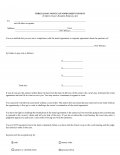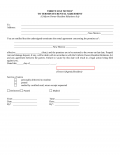Updated March 21, 2024
A New Mexico eviction notice is a formal letter sent by a landlord to a tenant who has violated their rental contract. The notice allows the tenant a statutory time period to remedy the issue. If the tenant does not fix the violation, the landlord will have the right to terminate the lease contract and file an eviction lawsuit.
By Type (3)
 3-Day Notice to Quit (Non-Payment of Rent) – Used to inform the tenant of their failure to pay the rent on time. The tenant will have three days to pay or move out before the landlord is allowed to seek legal action. 3-Day Notice to Quit (Non-Payment of Rent) – Used to inform the tenant of their failure to pay the rent on time. The tenant will have three days to pay or move out before the landlord is allowed to seek legal action.
Download: PDF |
 7-Day Notice to Quit (Non-Compliance) – For a lease violation other than non-payment of rent. The tenant will have seven days to respond or move out. If it is a second violation of the same non-compliance, then the landlord will have the option to terminate the lease and offer the tenant seven days to move out. 7-Day Notice to Quit (Non-Compliance) – For a lease violation other than non-payment of rent. The tenant will have seven days to respond or move out. If it is a second violation of the same non-compliance, then the landlord will have the option to terminate the lease and offer the tenant seven days to move out.
Download: PDF |
 30-Day Notice to Quit (Month-to-Month Tenancy) – Used to inform a tenant that the lease will not be renewed at the end of the term and that they have 30 days to move out. 30-Day Notice to Quit (Month-to-Month Tenancy) – Used to inform a tenant that the lease will not be renewed at the end of the term and that they have 30 days to move out.
Download: PDF |
Table of Contents |
Court Forms
Petition by Owner for Restitution (NMRA, Form 4-904) – To open an eviction case against a non-compliant tenant, the landlord will need to file this form and obtain a summons at the Magistrate Court (for a fee).
Summons – Informs tenant of the hearing date and location and is served on the tenant along with the Petition and Answer.
Answer to Petition – This form gives the tenant an opportunity to file a response and appear in court.
Writ of Restitution – If the tenant is non-compliant following a decision against them, the landlord will need to request this form to have the tenant removed by the sheriff.
How to Evict (3 steps)
1. Deliver Eviction Notice to Tenant
Before going to court to have a tenant removed, the landlord must exhaust the notice process first. Depending on the breach, the landlord must deliver one of the following notices to the tenant and then wait the requisite period of time, giving the tenant a chance to respond:
2. File Petition and Summons / Serve Tenant

If the tenant fails to rectify the problem or move out in response to the landlord’s notice in Step 1, the landlord may then go to the local magistrate court to file a Petition by Owner for Restitution and a summons with a fee of $77.[7]
The summons and petition must be properly served on the Tenant (for service information, see page 58 of the Renter’s Guide). It cannot be served by the landlord. It is probably a good idea to have the sheriff serve the papers. It must be served at least seven days before the court hearing.
3. Receive Court Judgment
If the tenant fails to show up at the hearing and/or the landlord is successful in his or her case against the tenant, the court will issue a judgment of restitution and give the tenant a date to move out which will be no more than seven days from the date of judgment. If the tenant still fails to move out. The landlord can ask the court to issue a Writ of Restitution and then the sheriff will be authorized to remove the tenant.


